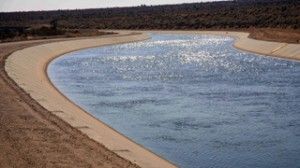No Shortage of Water Mythmakers
By WAYNE LUSVARDI
Does California have enough water?
Peter H. Gleick of the Pacific Institute in Oakland thinks not. He wrote yesterday in “Myths of California water shortfalls” that it is a myth there is enough water to meet 100 percent of the demands in California. But is Gleick exposing myths, or is he subtly posing his own counter-myths?
Dr. Gleick, PhD, is co-founder of the Pacific Institute (not same as the Pacific Research Institute, CalWatchDog.com’s parent institute).
Gleick’s group is a think tank for “water, sustainability and justice, and globalization” that is funded by a wide array of corporate, government and foundation sponsors, but whose board of directors is all green.
Mythical “Not Enough Water”
The curtain should be pulled back, says Dr. Gleick, on “one of the most common myths of California’s water situation — that there is enough water to satisfy 100 percent demand.”
Gleick asserts that it isn’t “some terrible person, agency, or water policy, or fish” that is “depriving humans of desperately needed water, even in time or record snowpack.” The real fault is in over-subscribed commitments to deliver “all the water they want all the time…resulting in eight times as many water rights given away as there is water available in an average year.”
Let’s take a look at Gleick’s claim.
California hasn’t built any resource reservoirs in decades, so his contention of lack of supply is superficially true.
But Gleick avoids focusing on the more important issue of the total supply of precipitation and imported water.
For example, California is considered a state in perpetual drought. But in 1998 — a wet year — rainfall and imports totaled 335 million acre-feet (MAF) of water, or enough water for 670 million urban households. That also would be enough water for about 1.675 billion people. Or 335 million acres of farming — more than ten times the current farming acreage of about 25 million acres.
And 64 percent of that water went to the environment, not farms, not industry, not cities and not suburbs.
Moreover, agriculture and industry, not urban cities, conserved 6.65 million acre-feet of water. That’s enough for 13.3 million urban households or 6.65 million acres of farming.
In a dry year in California such as 2001, there was “only” 145 million acre-feet of rainfall and imports. What was enough for 290 million urban households or 145 million acres of farming.
The problem is capture, storage and treatment — not drought, lack of conservation, the amount of water used by agriculture, global warming, unsustainability or population growth.
Mythical Eight Fold Water Rights
Writes Mike Wade of the California Farm Water Coalition, one of Gleick’s online adversaries:
He [Gleick] claims that the State Water Resources Control Board has acknowledged that there are eight times as many water rights given away as there is water available in an average year. The truth is that water rights permits are issued for time and place of use, not simply gross quantity.
A prime example is for power generation. A user may have a water right permit to generate power on a specific river. But such is not a consumptive use of that water. Multiple permits for the same water only mean that we are efficiently using it over and over again.
You would think Gleick would herald that as water-use efficiency, something he claims to support. But he doesn’t do that because it would pull the curtain back a little too far.
Mythical 75 percent of water goes to agriculture
Or let’s look at the widespread “fact” propagated by Dr. Gleick among many others that agriculture uses 75 percent to 80 percent of all “human” or “developable” water in California. Farmers say they use only 41 percent of water, while Gleick says the real number is 80 percent.
I contacted David Baryohay at the California Department of Water Resources (DWR), who said:
It is estimated that about 75 percent of California’s “Developed Water,” such as State Water Project and CVP (Central Valley Project), is delivered for agricultural purposes. However, the total ag use is about 43 percent (1995), reducing to 39 percent (by 2020). The data can be found in California Water Plans (1998, 2004, etc. — no operable link provided).
Mr. Barohay clarified that:
Developed water means water that is being captured by SWP (State Water Project) and CVP (Central Valley Project) projects. This water is runoff from precipitation and snowmelt that is being captured behind State and Federal dams and reservoirs. Groundwater and locally owned and operated water systems are not part of developed water. Water for agriculture is raw water (untreated). For use by humans (as potable), it must be treated before consumption.
In other words, agricultural water is raw water fit for irrigating crops but not for drinking water for humans. So Gleick’s contention that agriculture uses 80 percent of “human” water is like comparing apples with oranges — raw water with treated water.
However, his contention that it uses 80 percent of all “developable” water would render his claim in error. That’s because DWR indicates that agriculture uses 28 percent of dedicated supply in a wet year or at most 52 percent in a dry year.
According to DWR statistics, agriculture uses a mere 8.2 percent (27.7 MAF/335.5 MAF) of all precipitation and imports in a wet year. And only 23.4 percent in a typical dry year (34.1 MAF/145.5 MAF). I could not find third-party validation for Gleick’s 80 percent figure.
Mythical claim that drought was good for agriculture
The agricultural industry did not suffer during the recent past drought, claims Gleick, as “the total value of California’s agricultural products broke all records.”
Gleick conveniently ignores that farmers in one California valley undeniably did have their water cut off; and that farmers just shifted to use of groundwater supplies and alternative crops that use less water.
But Gleick is also opposed to farmers having the right to use groundwater given to them by the courts, federal laws or common law. He wants to undo the rule of the law and replace it with “groundwater management authorities,” presumably controlled by environmentalists rather than courts or a jury of common persons.
Southern California has had a long record of decentralized, self-governing — but adjudicated in state courts — water basin management without the need for some politicized, bureaucratic groundwater management agency.
Mythical No More Money for Large Water Projects
Another one of Gleick’s online adversaries, identified as “valuequestor,” refutes his statement, “There is no money for huge new projects to capture more” (water):
Really, Mr. Gleick? But we have money for bullet trains… yet “no more politically or environmentally acceptable places to build” dams. Acceptable to whom? I can’t think of a better public works project and can think of quite a few acceptable locations.
Gleick conveniently avoids discussing California’s five water bonds totaling $18.7 billion. That money mainly has gone for greenbelts and open space in wealthy northern California enclaves, without developing one new dam or reservoir. (See “New Year’s Water Bond Resolutions,” Calwatchdog.com, Dec. 27, 2010).
Mythical species extinction
“Taking as much water as we already do is driving fish, plants and other wildlife to extinction” is another one of Gleick’s mythical statements.
California decided long ago to value the downstream habitats of rose gardens, lawns and warm water fish such as bass and catfish in water canals, over upstream coldwater fish such as salmon or smelt. The “environment” can work either way — either as a warm water or cold water ecosystem. The choice is cultural and political, not environmental or scientific. If you get Channel Catfish instead of Coho Salmon it is called pollution; the same with “native” and “invasive” species.
To go back to an entirely primitive cold water ecosystem, as Gleick seems to want, would mean repealing civilization and modernity itself. It would mean going back to a time when the sea periodically flooded the Sacramento Delta and split California in two in near-tsunami fashion, wiping out nearly all human and animal habitats.
But there probably was abundant salmon fishing in Sacramento after the Delta flooded. And there probably were plenty of fish for baking sasa-kamaboko, a fish cake, in Sendai, Japan after the Tsunami of 2011; just no restaurants or homes to eat it in.
Dr. Gleick is a formidable green-water advocate. And being green and from the Bay Area in California typically serves as a cover for northern California water, including semiconductor manufacturing plants that consume as much water as a small city of 50,000, according to some environmentalists.
Mythmaker
As far as can be determined, Gleick is the primary source of the widespread myth that agriculture uses 75 percent to 80 percent of all “human” or “available” water in California, depending on whether Gleick wants to define total water supplies narrowly or broadly. This pernicious myth has been repeated so widely that even water officials believe it to be a fact (even this writer once did).
It is easy to proclaim all your opponent’s positions on water policy as myths when you assume a quasi-religious role as a mythmaker. Gleick is like a religious apocalyptic prophet of doom, only dressed up as a scientist. And like religious false prophets, his prophecies are typically inflated.
Declinist
In short, Gleick is what is called a “declinist,” who always portrays California’s water situation as declining due to farming and cities. While one of Gleick’s major rhetorical strategies is to call his opponents’ positions all myths, his declinist paradigm is mostly a myth that doesn’t hold water.
Gleick’s typical rhetorical device is to narrowly define his terms, then assert that the use of water by farms and cities is oversubscribed, overused and unsustainable.
This is somewhat comical when:
* Water is cyclical or recycled by nature;
* The same amount of water is on the earth now as millennia ago;
* As cited above, the amount of water precipitation in California could support a population of 100 million and a huge agricultural economy, while lessening the decimating impacts of flooding on wildlife as well as human habitats and life.
As they say in any contest, “know your opponent” and his methods.
Related Articles
Cal ISO focuses on Enron 2, not Cap & Trade manipulation
July 20, 2012 By Wayne Lusvardi A rerun is playing on TV of the inaccurate 2005 “documentary” movie, “Enron: The Smartest
Nitrogen fix could cancel CA fertilizer tax
A natural bacterial colonization process could end the proposed regulation of agricultural nitrate and taxation of fertilizer in California. Energy
Cal recovery lags USA
JUNE 7, 2010 By JOHN SEILER California’s economy is recovering, but more slowly than that of the rest of America,




